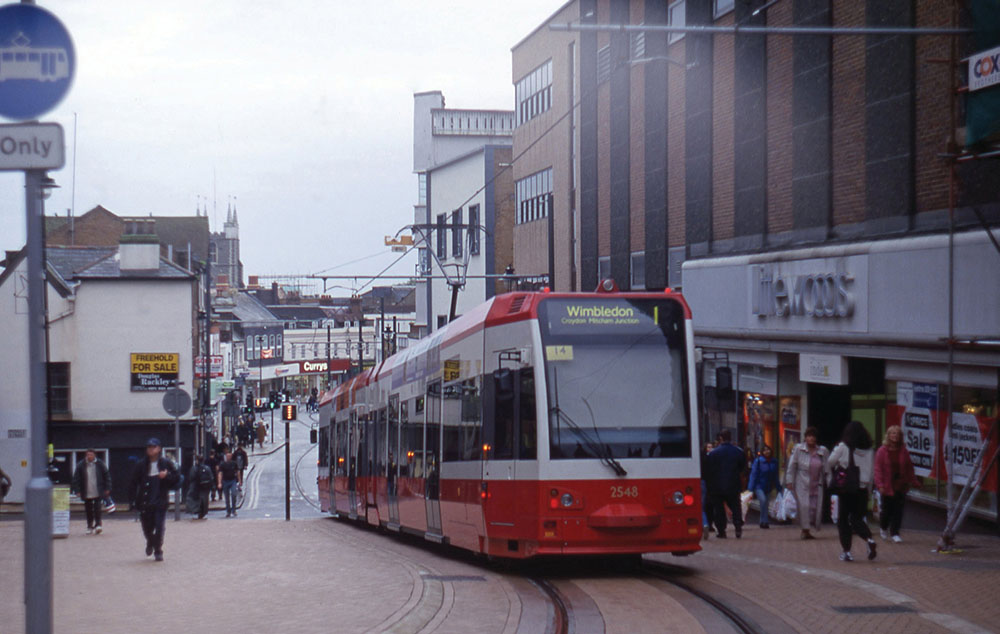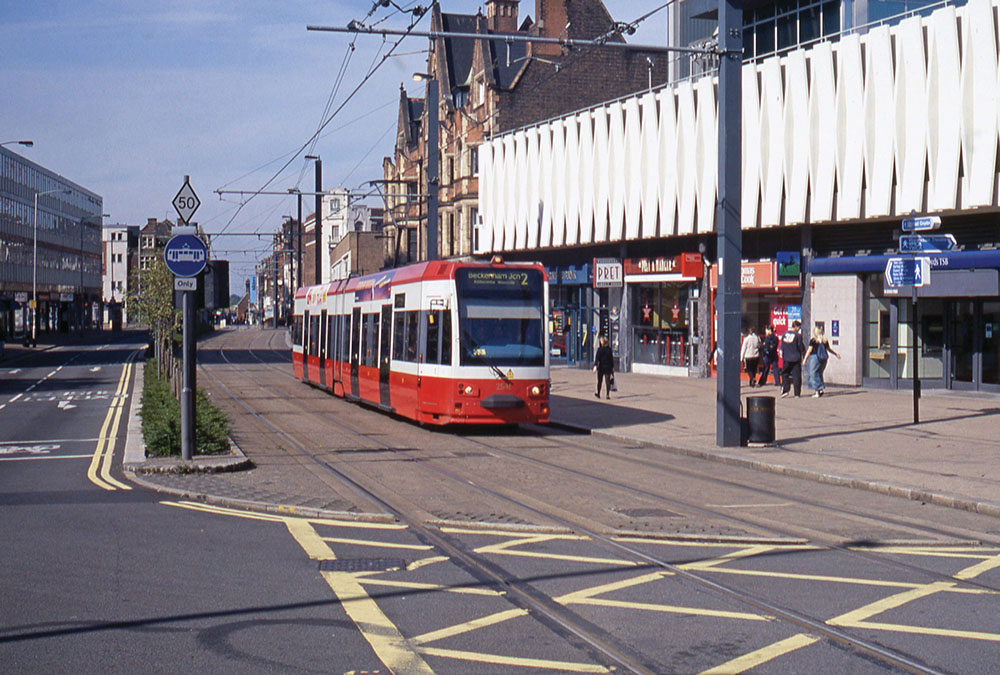

In order to improve its public transport connections, Croydon Council promoted in conjunction with London Regional Transport the development the Croydon Tramlink. Powers for the work, which included the replacement of certain sections of existing heavy routes as well as new construction, were obtained in the Croydon Tramlink Act of 1994. Two years later, Tramtrack Croydon Ltd – a consortium of Amey, Bombardier Transportation, First Group, Sir Robert McAlpine and the Royal Bank of Scotland – was given a 99-year Private Finance Initiative contract to build, run and maintain the system.
The two sections of ex-BR line required for construction – Wimbledon to West Croydon and from Elmers End to Addiscombe – both closed on 31 May 1997; the section reused from Woodside to Coombe Lane had already been closed (on 13 May 1983). The short section from Woodside to the branch terminus at Addiscombe was not converted as part of the Tramlink project and the original station and associated EMU depot were redeveloped.
The system opened in three stages: Croydon to New Addington on 10 May 2000; from Croydon to Beckenham Junction on 23 May 2000; and, from Croydon to Wimbledon on 29 May 2000. Although much of the system utilises private rights of way, through Croydon itself the track is road based. To operate the system, twenty-four articulated trams were supplied; in a nice gesture to the past, these were numbered 2530-53 as the last of London’s first generation trams was No 2529. The trams were also painted in traditional red. These 24 trams have been supplemented by an additional twelve supplied during 2012 (five), 2015 (five) and 2016 (two).

For the first time in almost 50 years, the streets of Greater London resounded to the noise and bustle of trackwork being undertaken as work progressed on the construction of Croydon Tramlink. This is the view outside East Croydon station in late 1998 as tracklaying is underway. Author

On 13 February 2000, Tramlink No 2539 heads eastbound along Addiscombe Road – to the east of East Croydon station – with a service heading towards Addiscombe. Author
Ownership of the system changed in June 2008, when Transport for London bought out Tramtrack Croydon Ltd for £98 million. The changed ownership resulted, in October 2008, in a change of livery with the red, which had been modified since its first introduction, being replaced by blue, green and white and the operation became simply known as ‘Tramlink’
One tragic element in the history of Tramlink occurred on 9 November 2016 when No 2551 derailed on the sharp curve approaching Sandilands tram stop from the New Addington. The accident resulted in the death of seven – the first fatalities in a tramway accident for many years (the last occurred in Glasgow in 1959) – and a further sixty-two were injured. The final report of the Rail Accident Investigation Branch, issued in December 2017, identified driver error as the cause of the accident. In addition, the report highlighted the use of toughened, rather than laminated, glass with the former not being strong enough to prevent passengers being ejected from the vehicle following its overturning.
Today, Tramlink operates over a seventeen route mile network with a fleet of thirty-six trams (although No 2551 is currently under investigation away from the line and will remain out of service for some time). There are plans for extending the system and increasing the capacity of the existing network.

Two Tramlink cars – No 2534 on a special working and No 2539 with a service to West Croydon – stand at the New Addington terminus on 18 October 2000. Les Folkard/Online Transport Archive

On 18 October 2000, Tramlink No 2548 is pictured descending Church Street. Les Folkard/ Online Transport Archive
DEPOT
The Croydon Tramlink is served by a single depot — Therapia Lane — which opened effectively with the launch of public services.
OPENING DATES
10 May 2000 Croydon to New Addington
23 May 2000 Croydon to Beckenham Junction
29 May 2000 Croydon to Wimbledon Arena to Elmers End
FLEET
2530-53
The first articulated trams delivered to Croydon Tramlink — the CR4000s — were built by Bombardier Transportation at Bautzen in Germany, with final assembly and testing being undertaken by Vossloh-Kiepe of Vienna in Austria. The numbering sequence followed on from the last of the first-generation trams — No 2529 — to see service in London and when first introduced were painted in a red and white livery similar to that adopted by London’s earlier trams. Following refurbishment of the fleet in 2008/09, all were repainted into a green, white and blue livery. The twenty-four trams were built originally between 1998 and 2000 and each can accommodate 208 passengers (70 seated and 138 standing). No 2551 was seriously damaged in the fatal accident at Sandilands on 9 November 2016.

Pictured approaching East Croydon station on 31 August 2003 is Croydon Tramlink No 2541. This was one of the original batch of twenty-four cars supplied for the system’s opening by Bombardier Transportation. Author
2554-65
In August 2011, six additional trams, Nos 2554-59, were ordered for Tramlink service; this time the order went to Stadler Rail, with construction being undertaken in Berlin with final streettesting being undertaken at Chemnitz, in Saxony. The first six Variobahn articulated cars were built during 2011/12 and can accommodate 206 passengers (72 seated with 134 standing). The first to enter service was No 2554, which was delivered on 24 January 2012 and first in service on 30 March 2012. A further six cars, Nos 2560-65, were subsequently ordered; these were delivered during 2015 and 2016.

The first of the Stadler Rail-built cars, No 2554, is seen in July 2012 shortly after the type was introduced to service. Six were initially ordered with a further six following during 2015 and 2016. Philip Hanson/Online Transport Archive